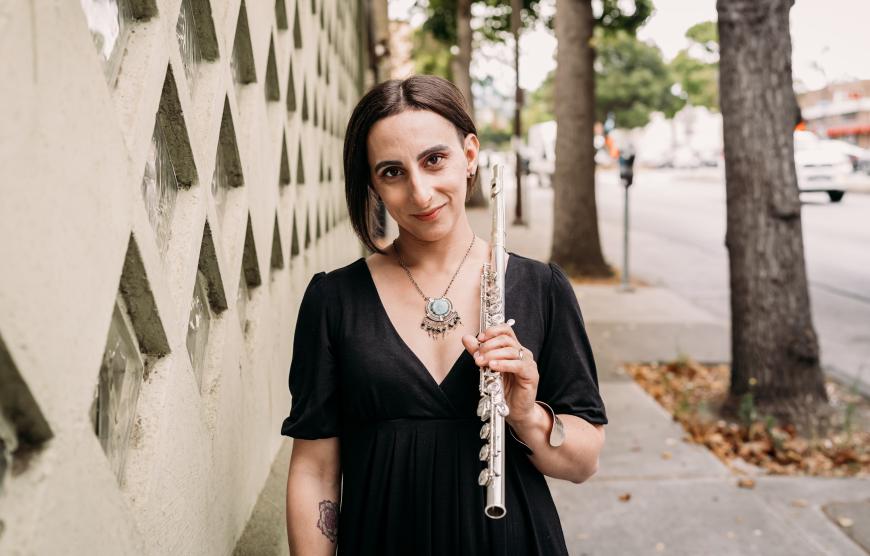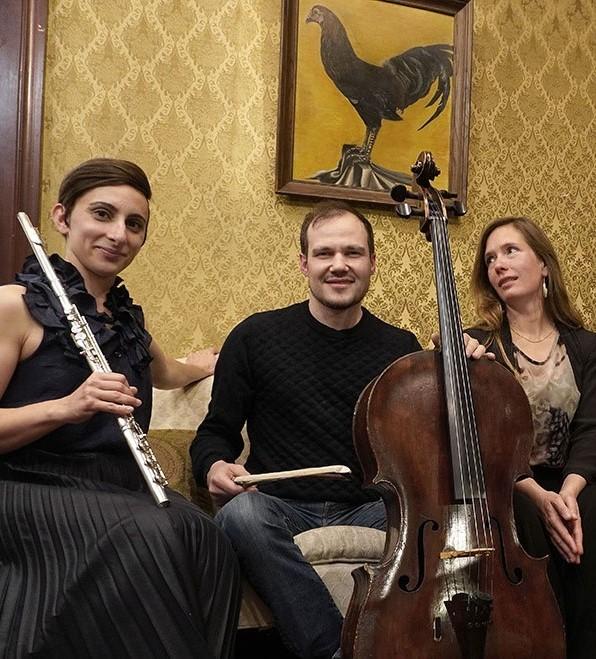
Rembetiko, a music brought by refugees to the underclass neighborhoods of urban Greece a century ago, gained global exposure in the soundtracks to Jules Dassin’s Never on Sunday (1960) and Michael Cacoyannis’s Zorba the Greek (1964). The song and dance genre, accompanied by violin and traditional Greek instruments, including the stringed bouzouki, bağlama, trixordo, and lyra, had also been adopted by Greek students and intellectuals, not unlike the revival of the American blues, bearing similar social origins.
Now, classically trained flutist Ellie Falaris Ganelin has incorporated remebetiko and other Greek forms into a program she calls “Uproot: Music From Asia Minor.” She’s touring the concert in the Bay Area and beyond with her Greek Chamber Music Project ensemble, which features herself, Athens-raised vocalist Katerina Clambaneva, fellow Athenian and pianist Elektra Schmidt, and cellist Lewis Patzner. (Jonathan Alford also takes the piano spot for one performance.)
GCMP, founded by Ganelin in 2011 and fiscally sponsored by InterMusic SF, has recorded and performed on both coasts. But “Uproot,” says Ganelin, “is my most personal project so far. It’s a shortcut to my ancestors. I hear this music, and I just tear up.” Her father is from Thessaloniki, Greece’s second city.

Last year, when GCMP appeared at SF Music Day, was the centennial of what’s known as the Asia Minor Catastrophe. In 1919, following the defeat in World War I of the Ottoman Empire (which fought on the side of the Germans), Greek troops had advanced on the neighboring Turkish region of Anatolia, otherwise known as Asia Minor. They hoped to secure control of the large Aegean port of Smyrna, where Greek Orthodox peoples, among an ethnically and religiously diverse population, had lived for many centuries.
But the three-year Greco-Turkish War ended in 1922 with the Greeks’ crushing defeat by troops of the new Muslim Turkish Nationalist Movement. Anatolian Greeks began to flee Smyrna and surrounding territory by land and sea. The Treaty of Lausanne, in 1923, mandated an “exchange” (in effect a forced migration) of Orthodox Christian Greeks in Turkey and Muslims in Greece.
“Sadly, all these neighbors were torn apart because of emerging national narratives [supported by the European Allied Powers],” notes Ganelin. Her great-grandmother, after abandoning Smyrna with her young children, reunited with her Greek solider husband on the island of Rhodes and then relocated to Athens, where Ganelin still has relatives. The swarm of refugees bolstered the population of Greece by 20 percent.
The refugees brought with them their unique synthesis of musical influences from the modal structures and melismatic vocal stylings of Ottoman and older Byzantine and Greek Orthodox traditions with regional dance-based meters, often notated in 9/4 or duple meter. In Smyrna and Constantinople, this music had been shared in what were known as “cafes aman.” The latter word, denoting “mercy” or “peace” in Arabic, was heard as an interjection in lyrics. Both the refugees and their music were at first denigrated by established Greek society as belonging to an impoverished underworld inclined toward unlawful behavior, including prostitution and the consumption of hashish, both of which also ended up in lyrics.

“About half the songs in our ‘Uproot’ program focus on the pain around the refugee crisis,” says Ganelin. Others celebrate the immigrants’ lifestyle and loves with both ardor and humor. Of the 12 songs (all sung in Greek), some are traditional, some composed, and with two exceptions they’re all arranged for chamber ensemble by Ganelin. She describes the program:
Our opening song, ‘Apo Xeno Topo,’ means ‘from a foreign land.’ It’s pining for a mysterious woman, and it actually exists in a lot of other languages, including Turkish, Arabic, and Hebrew. It cries out ‘aman.’ Then, ‘Menexedes kai Zouboulia’ [Violets and hyacinths] is a waltz with European influences. ‘Mortissa Smyrnia’ [Smyrniote lady] and ‘Kaigomai’ [I’m burning] are both from Smyrna. The latter, in the Turkish and Arabic saba mode, is a thinly veiled reference: You can imagine Smyrna on fire when the Turks occupied the city. On the surface, the lyrics have to do with unrequited love, but they also say, ‘When a person is born, a longing is born, and when the war breaks out, the blood is immeasurable.’
“‘Na Zei Kaneis sti Monaxia’ means ‘to live in loneliness.’ It’s probably the most serious piece on the program, and it talks about being ‘far from my dear mother, longing for her, like a boat without a sail, deprived of home and of oar.’”
About that last song, Ganelin adds, “It’s in the rembetiko tradition and the zeibekiko style,” the basis of Anthony Quinn’s swooping, tender dance with Alan Bates in Zorba the Greek. That film’s composer, Mikis Theodorakis, who fought against the U.S.-backed monarchy in the Greek Civil War and studied under French composer Olivier Messiaen, is represented on this program by his “Feggari Magia Mou ‘Kanes,” translated as “What have you done to me, magical moon?”
“‘Ti Se Melei Esenane’ [What’s it to you?] is a syrtos, an ancient circle dance,” Ganelin continues. “Many of these songs are from recordings from the 1920s and ’30s by Columbia and other labels recording in New York or Chicago. An example is ‘To Ouest’ [The west], which is our one American immigrant song. The lyrics actually refer to San Francisco, Sacramento, and Lodi. ‘Den Se Thelo Pia,’ which means ‘I don’t want you anymore,’ is of Neapolitan origin with a more operatic sound, but it was performed in Smyrna, which had been a very cosmopolitan place with opera houses and a movie theater.
“And there’s an upbeat song we’re ending with, ‘Ehe Geia Panagia,’ or ‘So long, Virgin Mary.’ It refers to various villages around Constantinople, saying, ‘We talked, and I forgot,’ but in an upbeat meter. This is very common in the Greek psyche, nostalgia and displacement in memory.”
Following on the mass displacements of the Asia Minor Catastrophe, Ganelin notes, “subsequent generations of refugees became more integrated into Greek society. “My grandfather went on to own a construction business and raise a family of his own. Although the catastrophe wasn’t in my history books, my family did talk about the uprooting, but it was painful. Last month, during the holidays, my dad was telling me stories here and there, and more details percolated. But even if we Greeks haven’t been talking about it for the last hundred years, the music is the thing that does the talking.”
Ganelin’s been delighted to discover affinities between the settings and sentiments of rembetiko and her classical community. “What I love about chamber music is how you get to respond to other players dynamically, and that, at its core, it’s a salon tradition where you’re in an intimate space and close to the audience. Greek music is performed similarly, in a cafe or a taverna, with everybody in chairs sitting close together. Now it has become foundational to me, even though I don’t have formal training in it.”
The Greek Chamber Music Project will present “Uproot” in San Francisco, Sacramento, and Oakland on Feb. 3, 10, and 12. And this spring, GCMP will perform for the San Francisco Greek Film Festival after a screening of Smyrna, a 2021 Greek docudrama about the Asia Minor Catastrophe, at the Delancey Street Screening Room, not far from the South Beach neighborhood favored by Greek immigrants early in the 20th century.



